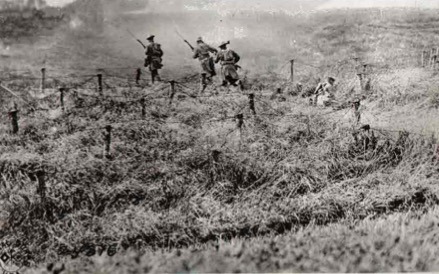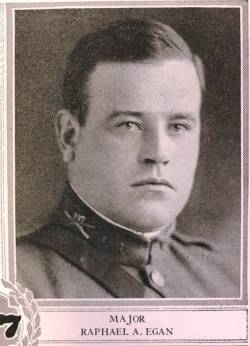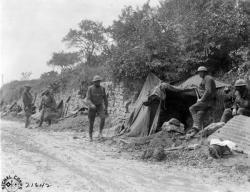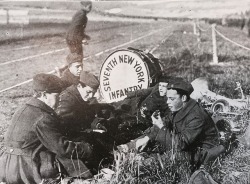

Today on Veterans Day, we salute all our veterans of the Armed Forces, past and present, and remember the men of the 107th Infantry in World War I. On this day in France in 1918, the 107th celebrated the signing of the Armistice with French and British troops. As veterans and active duty members gather today in the halls of the Armory to commemorate this centennial, we thank you all for your service and sacrifice.
Posted on Sunday, November 11th 2018


Tracking the Regiment: After the devastating Battle of Saint-Quentin, the 107th Infantry was given no rest. They continued to march from one skirmish to another going “over the top five times in three weeks” as one man put it. They were described by a fellow New Yorker as an “awful forlorn looking bunch, filthy and just completely all in.”
Then they regrouped with other US troops and the British Fourth Army in Saint-Souplet, France in mid-October. They hunkered down in dugouts and were incessantly shelled and shot by the German troops which had been refreshed with reserves. The objective for the Allied forces was to press through an estimated 50,000 German troops to free the occupied towns and farms in their way. Starting on Oct. 17 and ending on Oct. 20, the Battle of Saint-Souplet took an extreme toll on the 27th Division and the 107th lost 65 men in the struggle to claim ten miles of land. But the Germans were retreating. And at the end of this battle, the 27th Division received word that their service was over. They had no more replacement troops and they were too weak to fight effectively. The 107th Infantry and many others were to head home.
Posted on Friday, October 19th 2018

Tracking the Regiment: On September 29 and 30, 1918, Allied forces including the men of Seventh Regiment executed their attack at The Hindenburg Line. With tanks exploding around them, the men of Companies B and C encountered the enemy within 25 yards of launching their attack at great loss of life. Company D followed and captured 60 prisoners within the first ten minutes of battle. Trench after trench, the men pressed forward at great expense: more than half of the Regiment were either killed or injured on the first day of battle and only 5 officers remained, making it the largest daily loss in any American Regiment during WWI.

Included among the casualties was Captain Fancher Nicoll (Company L), a 39-year-old lawyer and father of two who joined the Regiment in 1900 and was part of two old New York families who dated back to the Revolutionary War. It was reported in The New York Times that even as Captain Nicoll himself was dying, he reached out his hand to comfort the wounded beside him.

Sgt. John C. Latham, Sgt. Alan Eggers and Cpl. Thomas O'Shea of Machine Gun Company, 107th, became separated from the regiment during the Battle of the Hindenburg Line. They took cover where they could, which ended up being in a shell hole within enemy lines. Hearing a cry for help, they realized it was coming from a disabled American tank nearby. All three left the safety of their shelter and headed toward the tank, despite the heavy machine-gun fire. The 23-year-old O'Shea was hit along the way and died. Latham and Eggers made it to the tank, where they were able to rescue a wounded officer and help two other soldiers find cover in a nearby trench. They headed back to the tank, despite the heavy fire, and wrestled the machine gun off, taking it back to the trench with the wounded men. They were able to use that gun to fend off German attackers for the rest of the day. When darkness fell, all of the surviving men were able to make it back to Allied lines. For their bravery and quick thinking, Latham, Eggers and O'Shea all earned the Congressional Medal of Honor.
By the end of the second day of battle, the Regiment sustained 335 casualties and 884 wounded men, having captured nearly 2,000 enemy troops. By October 1, the last major German defense line was penetrated, and the Allies continued to advance and attack the fleeing German troops in the open country beyond.

Posted on Sunday, September 30th 2018


Tracking the Regiment: In late September 1918 the men of the Seventh Regiment joined Allied forces at The Hindenburg Line—a well-planned German defensive position—in an effort to attack the stronghold at a key structural vulnerability near the St-Quentin Canal. Over several days, the men moved toward the front by boxcar and on foot, where they encountered a ravaged landscape that was described as “hideous indeed to behold” and marked by countless white crosses where Australian troops ahead of them had fallen. As they inched closer to the front, artillery fire from both sides grew more and more intense until it became one long, drawn-out roar. Wrote a soldier one night, “The guns of both sides seemed to spit hate…with a vengeance.” With British troops to their left and American, Australian, and French armies stretching nearly 40 miles to their right, the men readied themselves for coordinated a pre-dawn attack beginning September 29.

Posted on Friday, September 28th 2018




A conversation with Anne Teresa De Keersmaeker about The Six Brandenburg Concertos
“Bach’s musical oeuvre has always been a guiding light for me, from the very beginning of my career”—Anne Teresa de Keersmaeker
Read an interview with choreographer Anne Teresa de Keersmaeker ahead of the North American premiere of The Six Brandenburg Concertos at Park Avenue Armory, October 1–7.
Get Tickets: bit.ly/PAABrandenburg
Photos by Anne van Aerschot
Posted on Friday, September 21st 2018
Source rosas.be

Early in September 1918, while encamped near the town of Watou, Belgium, the 107th had a distinguished and honored visitor, the painter John Singer Sargent. “He wore the uniform of a British officer and looked a bit stouter and older than I expected he would from his portraits,” wrote Capt. Claude Leland of Company I. He made sketches of General O’Ryan and other Americans and even proposed to do a portrait of Captain Raphael Egan (who received citations for conspicuous courage and exceptional ability for his actions just the week before on the front line) but Sargent was pulled away to continue his travels before he could begin.
Learn more about Sargent’s visits to the front and his resulting painting Gassed (1919) on The Metropolitan Museum of Art’s Now at the Met blog.

Posted on Friday, September 14th 2018


In August 1918, the 107th Infantry concluded its rifles and maneuvers training near Saint-Omer, France and began its approach toward the front line in Belgium. One member of Company I captured the sense of foreboding among the troops, noting:
“No matter how much back-area bombing and long-range shelling a man had been through, the first time we went to the front line trenches in Belgium he made his will, wrote home for the last time, and prepared to be ‘bumped off.’”
Moving in small groups under the cover of night, the Infantry reached a section of the front line opposite Mount Kemmel between Ypres, Belgium, and Lille, France. Enemy shells shrieked and exploded ahead of them and the sharp staccato of machine guns grew louder as they inched forward. The regiment began to suffer casualties immediately, losing troops daily over the course of the two weeks they were stationed there.
The above photograph shows the conditions of a town near the front line. A member of the 107th Infantry depicted trench conditions in the above drawing, titled “In the trenches.”
Posted on Friday, August 31st 2018

Tracking the Regiment: In July 1918, the 107th Infantry was assigned to the Second British Army and deployed in reserve positions behind the front line from Ypres to Scherpenberg. They underwent more training, dug trenches and went on reconnaissance scouting missions. Intelligence reports showed that Crown Prince Rupprecht of Bavaria’s troops were primed for a grand offensive. This entire area was subjected to constant shelling and men in the troops were laying wagers that they would be on the front line within the next two weeks. They were right. Stay tuned for more posts commemorating the 100th anniversary of the Seventh Regiment’s involvement in WWI throughout the coming months, and look for posts tagged #107NYCentennial and #WWICC.
Posted on Thursday, August 2nd 2018

Happy Independence Day! Tracking the Regiment: After spending the month of June 1918 training for battle under the tutelage of British officers, the 107th Infantry began moving slowly across northern France toward the front in Belgium. They spent July 4th in the small town of Buysscheure, France (pop. 670) where they relaxed, the band played music and they had friendly boxing bouts and ball games until a passing German air squadron sent everyone scrambling for cover. The enemy was not supposed to know that the Americans were in the region.
Posted on Wednesday, July 4th 2018
Let it all go and learn “The Let Go” line dance! Choreographed by Francesca Harper specifically for Nick Cave’s “The Let Go” at Park Avenue Armory June 7–July 1, 2018.
Posted on Sunday, June 10th 2018

Notes